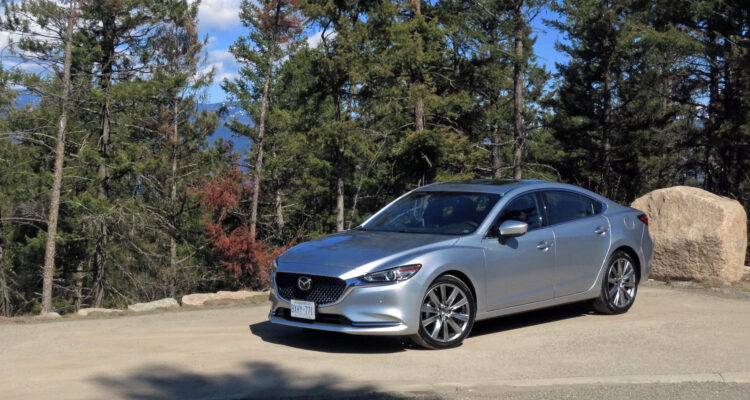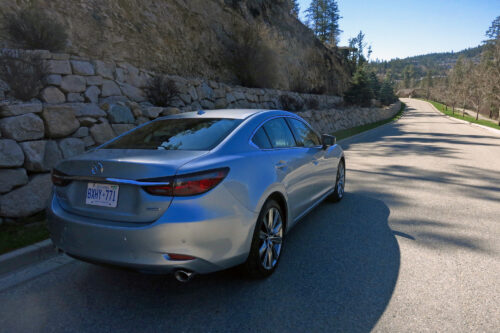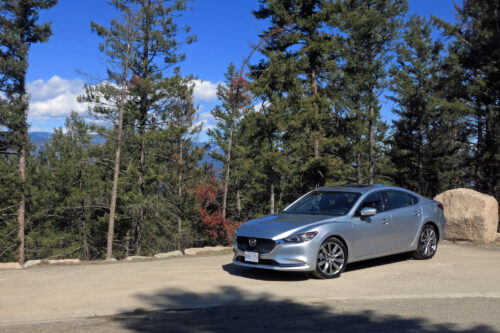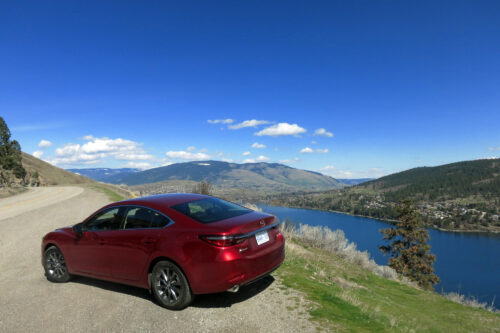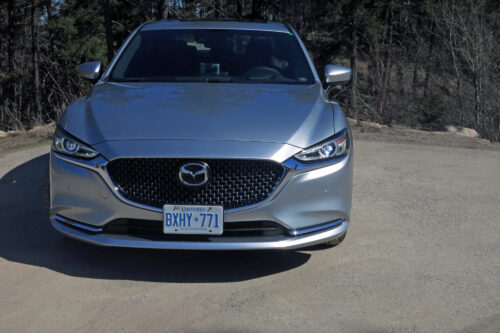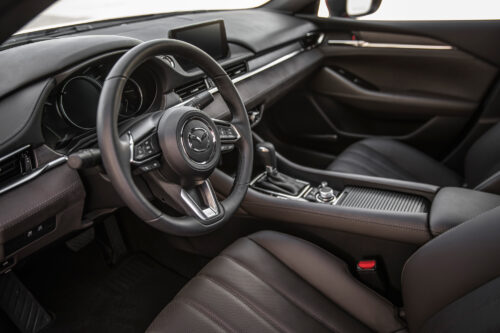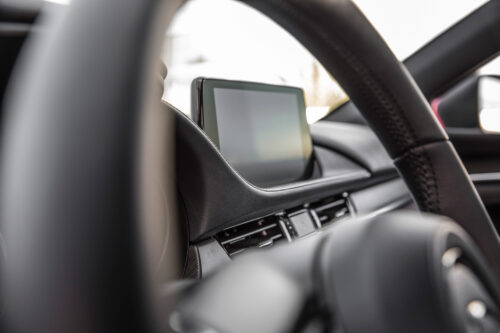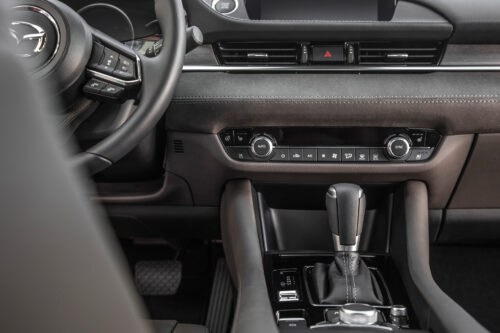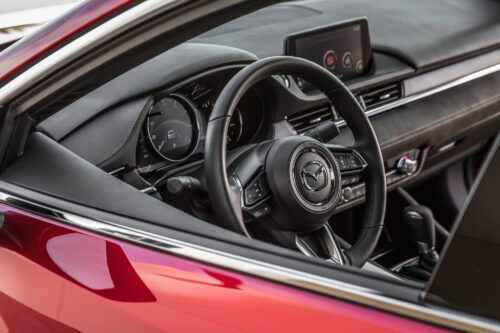When Mazda Canada’s Mark Peyman said the 2018 Mazda6 was the first sedan in Canada to get a four-cylinder motor with cylinder deactivation, veteran automotive journalist Jim Kenzie begged to differ.
“My Fiat 600 had it,” he said to laughter in the audience. Yes, retorted the others in attendance, but in the Fiat’s case, cylinders cutting out wasn’t exactly intentional.
Launching a somewhat radical refresh of a car that first hit the roads in 2012, Mazda’s changes go more than skin deep.
Two new motors are under the hood, a 2.5-litre normally aspirated four-cylinder with cylinder deactivation, and a 2.5-litre turbocharged four-cylinder delivering more than 300 foot-pounds of torque.
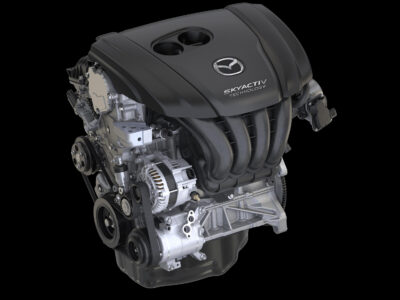
It’s the motors that are the big news here, one for fuel economy and one for added power (and not bad fuel economy). For our drive, the normally aspirated 2.5-litre motor, when cruising on the highway and running on two cylinders, dropped down to five litres per 100 kilometres on the instant fuel-economy display. For a midsize sedan, that’s hybrid territory without being a hybrid.
The second motor, a variant of the 2.5-litre dynamic pressure turbo in the CX-9 crossover, has peak horsepower of 250 and peak torque of 310 pound-feet. The nice flat torque curve transforms the Mazda6 from a capable family cruiser to a legitimate sports sedan that still only burns 10 litres per 100 kilometres in the city and 7.5 on the highway.
There are about 75 changes — to the car’s glass, wipers, acoustic sealing, floor pan, window channels and door seals, among others — that drastically cut interior noise.
There are new chassis and suspension changes to improve noise and handling and reduce weight.
There are tweaks to the exterior design and a radical revision to the interior.
“Here’s a photo showing the changes to the interior in red,” said Peyman, Mazda Canada’s national manager of product planning and strategy. The entire photo was red.
There’s a new dash design, new infotainment screen that’s an inch larger, new instrument panel display that declutters the gauges and uses a different font to improve readability. New seats, new centre console, new door panels and new air vents.
The new instrument panel replaces the speedometer with a seven-inch LCD screen that digitally mimics a conventional analog speedo. The change allows the speedometer to display only one measurement standard at a time, eliminating the clutter of a metric and Imperial set of numbers. (You can switch it between standards when crossing the border.)
There are enough changes it really qualifies as a redesign rather than a refresh, but it will take a knowledgeable observer to notice the changes from the outside. Peyman said the overall shape has held up well the last six years, so only minor changes were implemented, including a new rear fascia, new front, new headlights that integrate the fog lamps into the headlight housing, a larger grille, as well as a new grille design that has gone from horizontal bars to a crosshatch design.
The Mazda6 also gets a top-line Signature trim level, which first appeared on the CX-9 crossover. Signature loads the 6 to the rafters with technology, Nappa leather, ultrasuede accent panels on the dash and door panels, Sen wood accents. There are no options.
It includes high-speed autonomous braking, pedestrian detection, lane-keeping assist, the turbo motor and a gunmetal finish on the grille designed to catch the light and add a sense of depth to its appearance.
It is, interestingly enough, part of Mazda’s plan to expand the reach of its cars into the lower strata of premium brands, a strategy the company calls Mazda Premium. Peyman said the push is paying off, with increasing numbers of premium-brand shoppers including Mazda in their searches.
“It’s an exciting time for us in the brand, it’s a good transformation to be going through,” he said. “At the same time, we have to be careful to not say we’re becoming a premium brand.”
Instead, Mazda — which toyed with but dismissed the idea of creating a luxury brand (Amati) at the same time Honda, Toyota and Nissan launched Acura, Lexus and Infiniti — is maintaining a focus on the mainstream buyers, while offering the Signature model trim to draw in luxury-brand shoppers with a loaded, premium vehicle selling for less than the base price of its luxury competitors.
For example, a well-equipped base model Mazda6 begins at $27,000. The Signature series sells for $38,800. Peyman said the company expects the majority of buyers to opt for GT or Signature models.
The 2.5-litre normally aspirated motor is the only motor offered on the base-model GS. For $2,000, buyers of the GS-L model can upgrade to the 2.5-litre turbo. On GT and Signature, the turbo is the only offering.
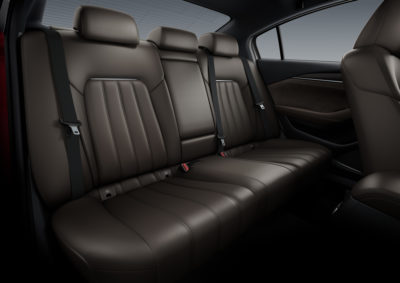
Sadly, the previous generation’s six-speed manual transmission has been sent packing. Starting with the 2018 model, only a six-speed Skyactiv automatic is available.
The ride and handling of the Mazda6 are exemplary, thanks to some revisions to front and rear suspensions. Bushings have been eliminated from the mounting points for the steering rack, improving steering feel and eliminating play. As well, changes to the rear multilink suspension reduce noise transfer to the cabin.
The car tracks around corners exceptionally well, with little lean and balanced handling that almost feels like a rear-wheel driver. The lightly sprung and well-damped suspension soaks up bumps, which also do not faze the car’s handling when you hit a bump in a faze.
The midsize sedan segment is going through a period of decline, with sales down throughout the segment, yet the Mazda6 has been growing, with the 2017 model gaining 23.8 per cent in sales to 2,541 units. Only the Volkswagen Passat, at three per cent, grew in 2017 in a segment down overall by 13.5 per cent.
With the new changes, with the addition of the Signature series, it appears Mazda is set to grow the Mazda6 even more.
2018 Mazda6
Engines: 2.5-litre four-cylinder with cylinder deactivation; 2.5-litre turbo
Power: 187 hp @ 6,000 rpm (2.5); 250 hp @ 5,000 rpm (2.5 turbo)
Torque: 186 lb-ft @ 6,500 rpm (2.5); 310 lb-ft @ 2,000 rpm (2.5 turbo)
Transmission: six-speed automatic
Steering: electric power rack-and-pinion
Brakes: four-wheel discs
Suspension: MacPherson strut with stabilizer bar, front; multilink with coil springs and stabilizer bar, rear.
Fuel economy (l/100 km, city/highway): 9.1/6.7 (2.5); 10/7.5 (2.5 turbo)
Price: $27,000 (GS); $31,600.00 (GS-L); $33,600.00, (GS-L with turbo engine); $35,800.00 (GT); $38,800.00 (Signature)



